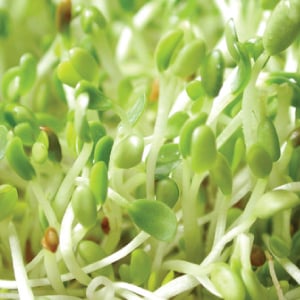
Learning Download: How to Grow Sprouts
From Seed to Harvest: A guide to growing sprouts.
Sprouting is a technique that uses water to germinate seeds, which are then eaten. Sprouts are a good option to grow for beginners, as they take only a week or two before they are ready to eat. They are a good source of vitamins and can make simple dishes appear more elegant. Since sprouts don’t require soil to grow and need minimal amounts f space, they are an excellent option for those living in an apartment or with limited yard space.
Sprouts come in many different kinds, and each variety of sprout has a different flavor, ranging from mild to the spicier radish sprouts. Sprouts are similar to microgreens, but the whole sprout, seed included, is consumed. Different sprouts are used in different dishes as they offer varying tastes. Traditional sprouts are green-leaf sprouts, which are seen as a small shoot with tow tiny green leaves. These are typically added to salads and sandwiches. Beans prouts are associated with the Mung bean, and they look like a white shoot with two small yellow leaves. Other kinds of sprouts include wheat grass, which can be substituted for whole grains in recipes, and lentil sprouts, which have a peppery taste. Adding sprouts to a diet is a way to increase vegetable intake.
To plant:
Sprouts don’t require soil to grow, just water to germinate and a little bit of time before they are ready to consume. Add the sprout seeds to a mason jar with cool water for 8 hours. The dry seeds are dormant and soaking the seeds ends the dormancy period.
To grow:
Drain the seeds after the 8 hours and then add them to fresh water again. Only use enough water to cover the seeds by a couple of inches. Repeat this process for three to five days until the seeds are sprouted and ready to consume.
To harvest:
Pat the seeds dry once they reach the desired size and refrigerate immediately. Sprouts expire quickly, so use them as soon as possible.
What sprouts crave:
Since sprouts are ready for consumption in as little as a week, fertilization is not necessary. However, precautions should be taken when consuming sprouts as they are grown in warm, moist conditions which also is the prime growing environment for bacteria such as E. coli and Salmonella.
Sprouts are easily perishable, so refrigerate them and consume as quickly as possible. It is safest to cook the sprouts, as the heat will kill any bacteria growing there, and it is suggested that children, the elderly and anyone who is ill should not consume sprouts. Homegrown sprouts aren’t necessarily any safer to consumer than store-bought ones.
Where to buy sprout seeds:
You can find many types of sprouting seeds including watercress, alfalfa, wheat grass and many more at Urban Farmer.
Learning Download: Sprouts and Sprout Mix Comparison Chart
Sprouts and Sprout Mix Comparison Chart
| Variety | Time to Sprout | Nutrition | Flavor |
| Alfalfa Sprouts | 4 Days | Vitamins A, B, C, E and K, Calcium, Iron, Magnesium, Phosphorous, Potassium, Zinc, Carotene, Chlorophyll, Amino Acids and Trace Elements.
Protein: 35% |
Crunchy and mild |
| Broccoli Sprouts | 4-6 Days | Vitamins A, B, C, E and K, Calcium, Iron, Magnesium, Phosphorous, Potassium, Zinc, Carotene, Chlorophyll, Amino Acids and Trace Elements.
Protein: 35% |
Broccoli flavor with a bit of heat |
| Chive Sprouts | 14-18 Days | Vitamins A, B, C and E, Calcium, Iron, Magnesium, Niacin, Phosphorous and Potassium.
Protein: 20% |
Garlic with slight heat |
| Daikon Radish Sprouts | 4-6 Days | Vitamins A, B, C, E and K, Calcium, Iron, Magnesium, Phosphorous, Potassium, Zinc, Carotene, Chlorophyll, Amino Acids and Trace Elements.
Protein: 35% |
Crunchy with a bit of heat |
| French Lentil Sprouts | 3-5 Days | Vitamins A, B,C and E, Calcium, Iron, Niacin and Phosphorous.
Protein: 25% |
Sweet and pepper flavor |
| Hard Red Wheat Sprouts | 2-3 Days | Vitamins B, C and E, Calcium, Iron, Magnesium, Pantothenic Acid and Phosphorous.
Protein: 15% |
Creamy, soft and chewy grain |
| Kale Sprouts | 3-4 Days | Vitamins A, B, C, E and K, Calcium, Iron, Magnesium, Phosphorous and Zinc.
Protein: 35% |
Mild sweet with a crunch |
| Red Clover Sprouts | 6-7 Days | Vitamins A, B, C, E and K, Calcium, iron, Magnesium, Phosphorous, Potassium and Zinc.
Protein: 35% |
Crunchy flesh, mild and refreshing |
| Red Garnet Amaranth Sprouts | 3-6 Days | Vitamins C, E and K, Calcium, Iron and beta-carotenes.
Protein: 15% |
Mild and sweet flavor |
| Bean Mix
(Green, Crimson and Red Chief Lentils; Green, Marrow and Yellow Peas; Beige Garbanzos and Adzukis) |
4-5 Days | Vitamins A, B, C and E, Calcium, Iron, Magnesium, Niacin, Phosphorous and Potassium.
Protein: 25% |
Crunchy and slightly sweet |
| French Mix
(Clover, Arugula, Cress, Radish and Dill) |
4 Days | Vitamins A, B, C, E and K, Calcium, Iron, Magnesium, Phosphorous, Potassium, Zinc, Carotene, Chlorophyll, Amino Acids and Trace Elements.
Protein: 35% |
Nutty with slight heat |
| Grain Mix
(Wheat, Spelt, Kamut, Lentils and Rye) |
3-4 Days | Vitamins A, B, C and E, Calcium, Iron, Magnesium, Niacin, Phosphorous and Potassium.
Protein: 15% |
Soft and buttery |

